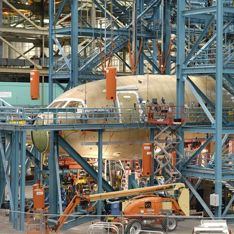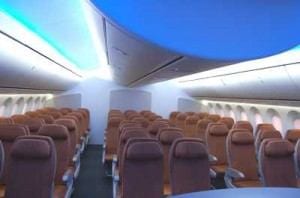Last week, the National Transportation Safety Board conducted two days of hearings into the Boeing 787 Dreamliner without uncovering a root cause of the battery meltdowns. Similar investigations took place in Japan with the same results. Still the Federal Aviation Administration (FAA) has cleared the Dreamliner to resume service. Service on United will begin again on May 31 and the aircraft is already back in flight with Ethiopian Airlines, while Japan’s ANA Airlines has also completed a test.
Should you book a seat on the next 787 flight? David DeVoss investigates whether the aircraft is ready for takeoff again.
In late 2011 Boeing launched a new commercial airliner. The official designation was the 787 but its name quickly morphed into the Dreamliner. Years in the making, the plane had something for everybody. Travelers remarked on the large dimmable windows, the easily accessible stowage bins, the LED lighting that made the cabin seem more spacious and the cleaner cabin air that allowed passengers to arrive more refreshed.
Airlines embraced the 787 because it was cheaper to operate. Largely built with carbon fiber composite materials instead of riveted aluminum sheets, the 787 was stronger, lighter and 20 percent more fuel efficient than any aircraft ever built. It was designed to carry up to 290 passengers up to 8,500 nautical miles – a third of the way around the Earth. But the plane’s main selling point was the lithium-ion batteries that enabled exceptional power generation and distribution.
Mechanical Problems with New Planes
 By the start of 2013, Boeing had delivered 50 Dreamliners and had orders for an additional 473. But then, four months ago, the batteries started to malfunction. On January 7 a lithium-ion battery on a Japan Airlines 787 caught fire despite the fact the aircraft was still parked at the gate at Boston’s Logan Airport. Later that month, a similar battery on an All Nippon Airways domestic flight triggered an emergency landing when it caught fire and filled the cabin with smoke.
By the start of 2013, Boeing had delivered 50 Dreamliners and had orders for an additional 473. But then, four months ago, the batteries started to malfunction. On January 7 a lithium-ion battery on a Japan Airlines 787 caught fire despite the fact the aircraft was still parked at the gate at Boston’s Logan Airport. Later that month, a similar battery on an All Nippon Airways domestic flight triggered an emergency landing when it caught fire and filled the cabin with smoke.
As history will tell us, new aircraft often experience troubled rollouts. The world’s first passenger jet airliner, the British-made DeHavilland Comet, suffered three crashes in 1953, killing 89 people. Metal fatigue caused by repeated repressurization at high altitude was discovered to be the problem and it was corrected, but the plane forever remained a commercial failure.
During the early 1970s, the McDonnell-Douglas DC-10 had a recurring problem with cabin pressure. The U.S. National Transportation Safety Board recommended strengthening the plane’s cargo doors, but McDonnell-Douglas objected to grounding the fleet until a Turkish Airlines DC-10 crashed after takeoff from Paris killing all 346 people aboard.
More recently, the Airbus 380 experienced two engine failures in 2010 and 2011 in planes sold to Qantas. The A380 also continues to experience cracks in its wings, but Airbus says it knows the source of the problem and airplanes delivered from 2014 onwards will be free of the defect.
The Dreamliner Airworthiness
 After three months of rigorous testing by Boeing engineers, the FAA two weeks ago certified the airworthiness of the Dreamliner. Almost immediately, Ethiopian Airlines put the first of its four 787s back in service and confirmed its desire to buy six more planes. In Japan, where ANA and JAL operate 24 Dreamliners with another 37 on order, all existing 787s should be back in the skies toward the middle of May.
After three months of rigorous testing by Boeing engineers, the FAA two weeks ago certified the airworthiness of the Dreamliner. Almost immediately, Ethiopian Airlines put the first of its four 787s back in service and confirmed its desire to buy six more planes. In Japan, where ANA and JAL operate 24 Dreamliners with another 37 on order, all existing 787s should be back in the skies toward the middle of May.
Boeing and GS Yusa, the Japanese company that manufactures the lithium-ion batteries, believes a reconfiguration of the battery will prevent further battery malfunctions. Electrical and thermal insulation will wrap each of a battery’s eight cells to prevent the malfunction of one cell from affecting the others. A new charging system will place less stress on the battery when it is being reenergized. Tiny vents will allow moisture to drain from the battery. Finally, all new batteries will be enclosed in seamless stainless steel to prevent fire or smoke from entering the passenger cabin.
Some 300 Boeing engineers now are working in nine countries to fix all existing Dreamliners, reports Ray Conner, Boeing executive vice president and CEO of the Boeing Commercial Airplanes division. “We are very confident in the solution that we’ve developed, the design changes that we’ve made and the testing we’ve used to validate the design. I speak for all of us that we would put our families on this airplane at any time,” says Conner.
Dreamliner safety problems have not hurt Boeing’s bottom line. The Chicago-based company last week reported that profits jumped 20 percent over last year with a corresponding 20 percent increase in corporate share value. “The appreciation of Boeing’s stock year-to-date has been impressive,” concludes Peter Arment, an aerospace analyst with Sterne Agee, a brokerage company headquartered in Birmingham, AL. “We feel there is more room to run given that the 787 battery problem has been laid to rest.”
Is a Contained Problem a Solved Problem?
 But should you rush out to buy a ticket on a Dreamliner? Boeing admits that three months of rigorous testing failed to discover the source of the earlier battery fires. Is containing a problem the same thing as eliminating it?
But should you rush out to buy a ticket on a Dreamliner? Boeing admits that three months of rigorous testing failed to discover the source of the earlier battery fires. Is containing a problem the same thing as eliminating it?
So far, indications are that passengers are ready to climb aboard and Boeing has responded with 300 engineers working in nine countries to upgrade all of its 787s.
But the deciding factor that should bring passengers flocking to Dreamliners are the creature comforts the aircraft offers. Large windows that dispel claustrophobia, fresher air at minimizes dehydration and lighting that slowly adjusts to the passing time zones are not inconsiderable advantages. In an age where airline meals consist of peanuts and pretzels and fees are charged for common courtesies environment matters.
Cautious travelers may wait until June to see how the Dreamliner’s revised electrical system performs. As for me, I’m ready to book space on the first United 787 going my way.
For more reports on the Dreamliner’s issues, check out:
- Peter’s CBS This Morning report on The Lithium Ion Battery Investigation
- Peter’s CBS This Morning the Financial Impact of the Dreamliner investigations
- Peter’s CBS This Morning report on the grounded plane, The 787 Grounded
- Peter’s January CBS This Morning report, How Severe Are the Boeing 787 Dreamliner Problems
By David DeVoss for PeterGreenberg.com. East-West News Service correspondent David DeVoss profiled the Dreamliner for this website when it first went into service.












